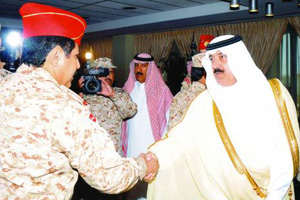A very important Arab leader in the American-Saudi Arabia security and defense relationship arrives to the nation’s capital today. To understand the significance of his visit, and as an aid in how to analyze the implications of visits between world leaders who grapple with internationally relevant issues of security and stability, a word about context and perspective might help.
Researchers and analysts examining and assessing the dynamics of defense and security relationships between allies are often guided by several factors. One is an understanding of the prevailing environment. Is it one of peace or war? If it is something resembling neither, does it more nearly approximate a brewing conflict, a fragile ceasefire, or an imminent mobilization and deployment of forces? Is there an anticipated intervention or troop withdrawal, a consideration of placing “boots on the ground,” aircraft in the sky, naval destroyers on the sea, submarines beneath the waves, or some other policy or opinion-shaping matter of concern? Then, recognizing the environment, what is one to make of its possible impact on the parties’ respective needs, interests, and key security, defense, and foreign policy objectives?
A second factor can be rooted in the allies’ military-industrial complexes, i.e., the state of relations between their respective aerospace and defense companies. A third can be the dynamics of their bilateral military-to-military relationships. A fourth can consider such matters as arms purchases or transfers. A fifth can relate to military education and training opportunities such as the U.S. International Military Education and Training Program, known as IMET, as it has long applied to Egyptians, Iraqis, Lebanese, various Arab North African countries, and the nationals of each of the six GCC countries.
A sixth can sometimes pertain to the prepositioning of security and defense structures, systems, and technologies, together with their maintenance and operations. A seventh can relate to access to and/or use of security or defense facilities. An eighth can focus on the forging, revision, or renewal of a security or military agreement allowing for continuous consultation, joint exercises, and periodic maneuvers. And a ninth can turn on the nature and number of exchanges of visits between and among the allies’ high-level security and/or defense personnel.
Visits between and among countries’ most senior security and defense leaders can matter and often do matter greatly. This last-named ninth factor is the one that most pertains to the arrival this evening by Saudi Arabian Minister of Interior HRH Prince Muhammad Bin Nayef Bin Abdalaziz Al Sa’ud and is the focus of the National Council essay that follows.
To help one understand the importance of Prince Muhammad’s visit, to appreciate the context and background for why he is coming at this time, and to anticipate and comprehend the issues that he might raise for discussion, the National Council on U.S.-Arab Relations is pleased to learn from Council Distinguished International Affairs Fellow Dr. Imad Kamel Harb.
FIGHTING EXTREMISM AND CLARIFYING COMMITMENTS: HRH Prince Mohammad Bin Nayef’s Visit to Washington
By Dr. Imad Kamel Harb
December 8, 2014

Prince Mohammad bin Nayef receives U.S. Senator John McCain in Riyadh, Saudi Arabia, in December 2013. Photo: Mohammad Bin Nayef Counseling and Care Center.
Saudi Arabian Interior Minister, HRH Prince Mohammad bin Nayef bin Abdul-Aziz Aal Saud, comes to the American capital this week to continue consultations on a host of issues of mutual interest to Saudi Arabia and the United States. As Interior Minister with additional responsibly for the kingdom’s policy toward the Syrian crisis, Prince Mohammad is uniquely positioned to coordinate with American officials Saudi Arabia’s efforts against violent extremism, militancy, and the continuing slaughter in Syria. Coming on the heels of the recent visit by Minister of the Saudi Arabian National Guard, HRH Prince Mit`eb bin Abdulla bin Abdul-Aziz, this visit further highlights the important strategic relationship between Riyadh and Washington that serves the interests of peace, security, and stability in the Middle East.
Waging War on Extremism
An essential element of Prince Mohammad’s visit consists of coordinating respective visions, policies, and plans to challenge the scourge of radical militancy in the Arabian Peninsula and Iraq. Since the September 11, 2001, attacks on the United States, when Prince Mohammad first took charge of the kingdom’s counter-terrorism policy as assistant to his late father, HRH Prince Nayef bin Abdul-Aziz, who himself served as Interior Minister for 37 years, Saudi Arabia has been a linchpin in global efforts to fight terrorist financing, recruiting, and ideology.




You must be logged in to post a comment.